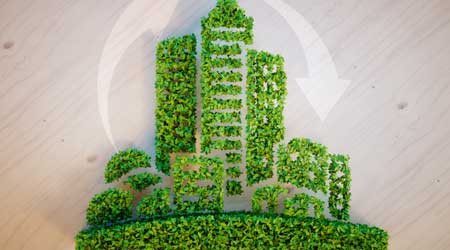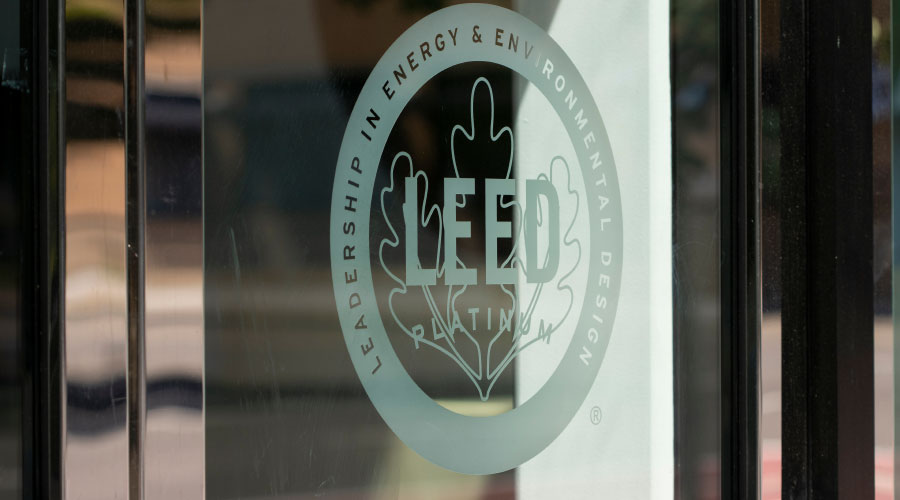Now Is the Time for LEED Certification
New guidance and tools support facility teams with healthy, sustainable re-entry and measuring ongoing performance.
Twenty years ago, the Philip Merrill Environmental Center achieved the first LEED Platinum certification, revealing that a high-performing, efficient space can also deliver important human and environmental health benefits. Since then, more than 103,000 projects in nearly 180 countries and territories have taken steps toward certification.
For these projects, and more to come, LEED has been a roadmap for creating healthy, resilient, sustainable buildings. Its comprehensive and holistic approach connects the dots between design, construction, and operations. As companies and governments look for ways to reduce their impact on the environment and support climate goals, they realize that those goals cannot be achieved without improving the buildings and spaces they occupy. LEED’s ability to help reduce carbon emissions and energy and water use, divert waste, prioritize healthier materials and more, has helped make the rating system the predominant green building standard for the industry.
The adoption of LEED, though, goes beyond environmental stewardship. Over the years, project teams have seen LEED as a tool that also creates a healthier working environment for people. In a 2018 USGBC survey of employees working in LEED buildings, more than 90 percent of respondents say they are satisfied on the job and 79 percent say they would choose a job in a LEED-certified building over a non-certified one. Respondents indicated that access to quality outdoor views and natural sunlight boosted their productivity and enhanced air quality improved their physical health and comfort. The benefits LEED buildings provide for people has become a recruiting tool for companies that want to show prospective and current employees, as well as clients they are a place that cares about its people.
The adoption of LEED over the years has been a disruptor to the market and created new economic opportunities for industries and businesses. The green building materials market has skyrocketed and by 2022 is expected to reach more than $360 billion. Among building owners and managers, LEED buildings are commanding higher rents and lease up rates while vacancy rates are 4 percent lower than non-green properties. Operating cost savings, shorter payback periods, and increased asset value have also been consistently reported. An estimate from LEED-certified buildings from 2015-2018 showed significant cost savings, including $1.2 billion in energy, $149.5 million in water, $715.3 million in maintenance and $54.2 million in waste. Investors also see certification as a tool to help meet environmental, social, and governance (ESG) goals and monitor progress across portfolios. LEED’s ability to deliver results and speak to a variety of stakeholders is in part why it remains an effective leadership standard.
As green building practices have become more mainstream, new technologies and strategies have emerged. LEED itself has continued to evolve to meet the demands of the market and capitalize on these improvements, ensuring it continues to push the market when it comes to sustainability.
With the launch of LEED v4.1, the latest version of the rating system, the green building industry celebrated another milestone and an opportunity to raise the bar on what it means to create and operate a healthy, sustainable space. LEED v4.1 shifted the focus to data and metrics and set projects up to continually track and report sustainability performance using Arc. The Arc technology platform allows teams overseeing the sustainability of buildings and spaces to benchmark and track progress. The ability to encourage ongoing measurement and ensure a space continues to operate as intended is critical to helping businesses decarbonize and demonstrate improvement to tenants and stakeholders.
Getting more buildings focused on performance means making the tools that track and measure it more accessible. Not all buildings are ready to pursue LEED, but all buildings can start measuring and tracking progress. By doing so, facility teams can see how small decisions can take them one step closer to the leadership standards LEED outlines. In 2019, Arc became available for free to all buildings and spaces. Now, any space anywhere can start benchmarking and tracking energy, water, waste, transportation-related emissions, occupant experience and indoor air quality. Arc provides reports and category-level performance certificates that become a steppingstone to a LEED certification.
Supporting health and wellness
Data opens up a new way to communicate how operations decisions support people and communities. During a pandemic the ability to track and report on building systems and performance has never been more important. Facility teams are already making adjustments to their spaces to help mitigate the spread of the virus and keep tenants safe and it’s brought a renewed focus to how buildings impact people. Health has been a central part of green building for many years, because strategies that are good for the environment often have important individual and global health benefits. In LEED v4.1, nearly two-thirds of the credits relate to health and wellness. The rating system has been a framework that helps teams understand how sustainable decisions also support people. The pandemic has catapulted these strategies into a new spotlight and revealed areas where new guidance is needed to support owners and building teams as they work to reassure people that these spaces are safe and healthy.
To support facility teams and owners in those efforts, USGBC introduced four new Safety First pilot credits. The credits outline sustainable best practices that align with public health and industry guidelines. It outlines approaches for cleaning and disinfecting, workplace re-occupancy, indoor air quality and water systems. The credits can be used by LEED projects that are certified or are undergoing certification.
The Safety First: Cleaning and Disinfecting Your Space credit requires facilities to create a policy and implement procedures that follow green cleaning best practices to support a healthy indoor environment and worker safety. Current disinfectants and cleaning processes are effective against the virus and sustainable options exist that can help reduce the amount of toxins and pollutants being introduced into a space. In addition to product considerations, procedures and training for cleaning personnel, occupant education, and other services are also required.
The Safety First: Re-Enter Your Workspace credit is a tool to assess and plan for re-entry, as well as measure progress once a space is occupied. It identifies sustainable requirements in building operations and human behavior that take precautions against the spread of COVID-19. It aligns with the American Institute of Architects (AIA) Re-occupancy Assessment Tool and requires transparent reporting and evaluation of decisions to encourage continuous improvement.
The Safety First: Managing Indoor Air Quality During COVID-19 credit builds on existing indoor air quality requirements and credits in LEED. Building teams should ensure indoor air quality systems are operating as designed and determine temporary adjustments to ventilation that may minimize the spread of COVID-19 through the air. Additional considerations include increasing ventilation and air filtration, physical distancing of occupants and following measures outlined in public health and industry resources, as well as guidance found in the Re-Enter Your Workspace credit. Facility teams are also encouraged to monitor and evaluate indoor air quality on an ongoing basis.
The Safety First: Building Water System Recommissioning credit helps building teams reduce the risk that occupants are exposed to degraded water quality. Building and business closures over months reduce water usage that can potentially lead to stagnant water and water that is unsafe to drink or use. The credit integrates recommendations from industry organizations and experts, including the U.S. EPA and CDC. It requires buildings to develop and implement a water management plan, coordinate with local water and public health authorities, communicate water system activities and associated risks to building occupants and take steps to address water quality from the community supply, as well as the building.
The credits are an important element for any building or space that has achieved LEED or is pursuing certification. It provides actionable guidance that conveys to tenants and stakeholders that steps have been taken to support their health and safety. LEED’s ability to be flexible and bring new strategies for the market to test is intrinsic to the character of the rating system. It’s a resource the market can rely on, because it provides a path forward, which is needed and necessary during times of crisis.
To complement LEED’s Safety First credits, facility teams can also take advantage of Arc Re-Entry, a new offering that once again reinforces the importance of data in tracking re-entry policies and procedures. It provides teams with a set of tools to document and benchmark infection-control practices, collect and analyze occupant experiences, and measure indoor air quality around carbon dioxide, relative humidity, and particulate matter. The tools evaluate the relationship between expectations for policies and the occupants’ experiences with them. It is also a method teams can use to identify opportunities for LEED’s Safety First credits.
Adopting these new credits and performance tools are not only about responding to the current pandemic, but it’s a way to reinforce that a building is committed to supporting a healthy, sustainable future. With LEED v4.1, building teams also have a streamlined way to recertify, which effectively shows occupants, investors and other stakeholders that a property is being operated and maintained according to the latest green building standards and certification is a verification of those efforts.
As the world battles two monumental challenges – climate change and a pandemic – now is the time for facility teams to double down on practices that improve efficiency and promote environmental and public health.
Melissa Baker is senior vice president for technical core at the U.S. Green Building Council. She works across all building sectors to engage, define, deploy, and drive enhanced investment in high-performing real estate assets through the LEED green building ratings system.
Related Topics:












